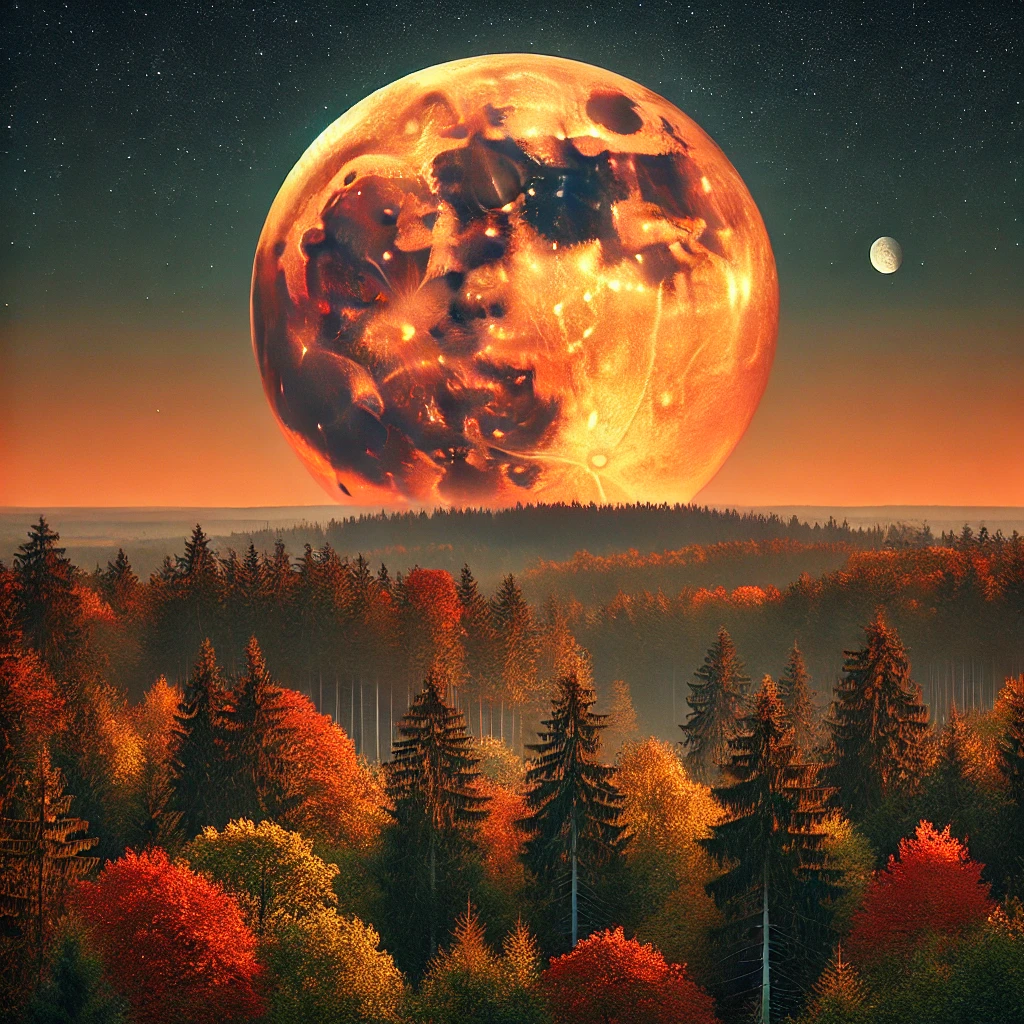Introduction
The Hunter’s Moon is one of nature’s stunning spectacles, captivating skywatchers around the world with its glowing brilliance. It is a term used to describe the first full moon following the Harvest Moon, which is the full moon nearest to the autumnal equinox. With its roots in ancient traditions and agricultural practices, the Hunter’s Moon has become a symbol of change, harvest, and preparation for the colder months ahead. This article explores the history, significance, and natural beauty of the Hunter’s Moon.
What is the Hunter’s Moon?
The Hunter’s Moon is the full moon that appears after the Harvest Moon, typically occurring in October or early November. Unlike other full moons, the Hunter’s Moon rises soon after sunset, creating a uniquely bright and prolonged period of moonlight. This phenomenon allows for extended visibility during twilight, which has been historically significant for hunting and preparing for winter.
History and Cultural Significance of the Hunter’s Moon
The name “Hunter’s Moon” dates back to ancient times, when the moon’s glow played a crucial role in survival:
- Agricultural Roots: After the Harvest Moon helped farmers gather crops, the Hunter’s Moon provided extra light for hunters to track game and stock up on food. This was especially important in regions with harsh winters, where resources needed to be gathered before the first frosts.
- Indigenous Traditions: Native American tribes also named this full moon the Hunter’s Moon, as it marked a time to hunt and store food for the winter months. It served as a reminder to prepare for the upcoming cold season.
- European Folklore: In Europe, the Hunter’s Moon was also known as the “Blood Moon” or “Sanguine Moon” due to the reddish hue it sometimes takes on when rising through the atmosphere. This added a mystical element to its appearance, making it a subject of legends and stories about the transition from autumn to winter.
When Does the Hunter’s Moon Occur?
The Hunter’s Moon follows the Harvest Moon, which means its timing is tied closely to the autumnal equinox:
- October or November: The Hunter’s Moon typically occurs in October but can sometimes fall in early November, depending on the lunar cycle. This year-to-year variation is why it’s important for skywatchers to check lunar calendars for the exact date.
- Rising Times: Unlike other full moons that rise about 50 minutes later each night, the Hunter’s Moon rises around 30 minutes later, creating a short period between sunset and moonrise. This unique timing allows for a longer period of twilight illumination.
Unique Features of the Hunter’s Moon
- Enhanced Illumination: The Hunter’s Moon is known for appearing larger and brighter due to its proximity to the horizon when it first rises. The extra light provided during the twilight period made it easier for ancient hunters to see their prey.
- Visual Appeal: As the Hunter’s Moon rises, it often appears to be a deep orange or red due to the scattering of light through the Earth’s atmosphere. This gives it a dramatic and colorful appearance, making it a favorite among photographers and stargazers.
- Moon Illusions: The Hunter’s Moon, like other full moons, can create a “moon illusion” where it appears larger when it is closer to the horizon. This optical illusion is caused by the way our brains perceive the moon in relation to objects on the ground, such as trees and buildings.
How to Observe the Hunter’s Moon
For those looking to enjoy the beauty of the Hunter’s Moon, here are a few tips:
- Check Local Timing: Find out the exact time of moonrise in your area using online astronomy calendars or mobile apps. This will help you catch the Hunter’s Moon just as it begins to rise.
- Choose the Right Spot: For the best view, find a location with a clear view of the eastern horizon, as this is where the moon will appear during moonrise.
- Capture the Moment: Bring a camera or binoculars to capture the stunning colors and details of the Hunter’s Moon as it moves through the sky. The first few moments of moonrise often provide the best photo opportunities.
- Enjoy the Experience: While taking photos is great, don’t forget to simply enjoy the experience. The sight of the Hunter’s Moon rising over the horizon is a peaceful and awe-inspiring moment.
FAQs About the Hunter’s Moon
- Why is it called the Hunter’s Moon?
The name comes from ancient traditions when hunters used the additional light from this full moon to hunt game and prepare food for the winter season. - How is the Hunter’s Moon different from the Harvest Moon?
The Harvest Moon is the full moon closest to the autumnal equinox, while the Hunter’s Moon is the full moon that follows it. Both are known for rising soon after sunset, providing extra light during twilight. - Does the Hunter’s Moon have a special color?
The Hunter’s Moon often appears orange or red when it first rises due to the scattering of light through the Earth’s atmosphere. This effect is most visible when the moon is near the horizon. - Can I see the Hunter’s Moon from anywhere in the world?
Yes, the Hunter’s Moon is visible to anyone with a clear view of the sky. However, the best viewing times and conditions depend on your location, so it’s good to check a local lunar calendar. - Does the Hunter’s Moon affect wildlife?
Yes, many animals are influenced by the brightness of full moons, including the Hunter’s Moon. It can impact the behavior of nocturnal animals, making them more active during this time. - What makes the Hunter’s Moon appear larger?
The Hunter’s Moon can appear larger when it rises due to the “moon illusion,” an optical illusion where the moon seems bigger when viewed near the horizon compared to when it is higher in the sky. - Can I see the Hunter’s Moon without any special equipment?
Absolutely! The Hunter’s Moon can be observed with the naked eye, making it a great celestial event for all levels of stargazers.
Conclusion
The Hunter’s Moon is more than just a beautiful full moon in the autumn sky; it is a celestial event steeped in history and tradition. Its unique timing and brilliant glow have made it a symbol of change, preparation, and the transition from harvest to winter. Whether you’re a seasoned astronomer or simply enjoy looking at the night sky, the Hunter’s Moon offers a wonderful opportunity to connect with the rhythms of nature and appreciate the beauty of our universe.





